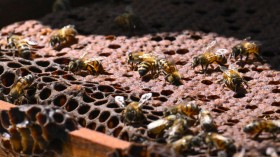Chronic disease can wreak havoc on a pack of wild animals living together, but new research shows that if carnivores simply cooperate, they can lessen their impact and increase their chances of survival.
At least, that's what researchers at Penn State found after studying gray wolves in Yellowstone National Park and the incidence of mange, a class of skin diseases caused by parasitic mites. Their findings, published in the journal Ecology Letters, are among the first to measure the costs of infected non-human individuals of any species on members of their group.
"Our research with wolves illustrates that social groups can help to offset the survival costs of infection with the parasite that causes mange," Emily Almberg, a research scientist at Penn State University and the lead author of the study, said in a statement. "It suggests that social living might help individuals cope with a variety of other chronic conditions - including other infections, physical injuries, or non-infectious diseases - for which having access to supportive care and resources can make a big difference for survival."
According to the study, wolves living alone while infected with mange had a death rate that was five times higher compared to uninfected wolves living alone. However, those that were living in a pack with at least five other healthy wolves had the same rate of death as their healthy companions, despite being infected with mange.
"Our hypothesis is that pack-mates are able to offset the survival costs of infection with mange - and perhaps other infections - by assisting with food acquisition and territory defense," explained Peter Hudson, the study's senior author.
In addition, the Penn State team also realized that the size of the wolf pack did not predict the risk of individuals becoming infected with mange. Nonetheless, there are other situations in which social living does make carnivores more at-risk for disease transmission.
"What we've under-appreciated in the past are the ways in which social species might compensate for this increased disease risk," Almberg said. "In some cases, social species exhibit adaptive behavior to limit the spread of disease - things like defending territories or having distinct social roles within the group that limit contact and therefore disease transmission, but our research has shown that group living can alleviate the actual cost of an infection as measured by survival rates."
For more great nature science stories and general news, please visit our sister site, Headlines and Global News (HNGN).
© 2024 NatureWorldNews.com All rights reserved. Do not reproduce without permission.





